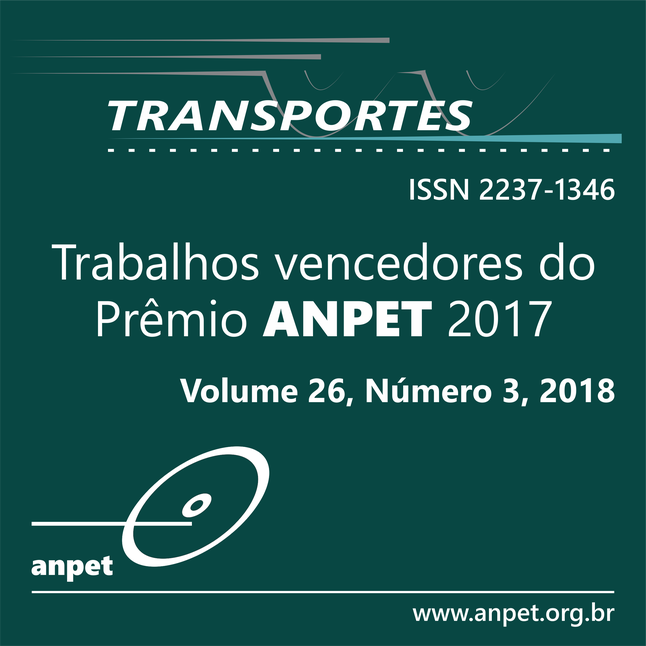Uma avaliação multiobjetivo de atendimentos de emergência com base na população, no número de ocorrências e na distância percorrida pelos veículos de resgate
DOI:
https://doi.org/10.14295/transportes.v26i3.1643Palavras-chave:
Despacho de veículos de resgate, Localização/alocação de facilidades, Máxima cobertura.Resumo
Serviços Médicos de Emergência são considerados elementos críticos dos modernos sistemas de saúde, por precisarem assegurar que seu nível de serviço esteja adequado à população a qual servem. Neste sentido, Problemas de Localização de Facilidades têm sido aplicados com o intuito de indicar locais estratégicos para bases de despacho de ambulâncias que atendem às ocorrências de emergência. Este trabalho tem como objetivo realizar uma avaliação multiobjetivo de atendimentos de emergência, por meio de um modelo matemático, que considera a população atendida, o número de ocorrências e a distância percorrida pelos veículos de emergência para atendimento. Cenários são produzidos para permitir variações do tempo de resposta, do número de bases de despacho e do número de veículos disponíveis. Um estudo de caso envolvendo o município do Rio de Janeiro foi considerado para exemplificar a avaliação multiobjetivo proposta. Foram considerados cerca de 105 mil registros, entre ocorrências gerais e acidentes de trânsito.
Downloads
Referências
Alsalloum, O. I. e G. K. Rand (2006) Extensions to emergency vehicle location models. Computer & Operations Research, v. 33, p. 2725-2743. DOI: 10.1016/j.cor.2005.02.025.
Aringhieri, R.; G. Carello e D. Morale (2007) Ambulance location through optimization and simulation: The case of Milano urban area. Proceedings of XXXVIII Annual Conference of the Italian Operations Research Society Optimization and Decision Sciences, AIRO, Genova, Italy, p. 1-29.
Ball, M. O. e F. L. Lin (1993) A reliability model applied to emergency service vehicle location. Operations Research, v. 41, p. 18–36. DOI: 10.1287/opre.41.1.18.
Bélanger, V.; Y. Kergosien; A. Ruiz e P. Soriano (2016) An empirical comparison of relocation strategies in real-time ambulance fleet management. Computers & Industrial Engineering, v. 94, p. 216-229. DOI: 10.1016/j.cie.2016.01.023.
Brotcorne, L.; G. Laporte e F. Semet (2003) Ambulance location and relocation models. European Journal of Operational Re-search, v. 147, p. 451–463. DOI: 10.1016/S0377-2217(02)00364-8.
Caliper. (2008) TransCAD - Transportation Workstation Software, Versão 5.0. Caliper Corporation, Newton, USA.
Chung, C.; D. Schilling e R. Carbone (1983) The capacitated maximal covering problem: a heuristic. Anais do Proceedings of the Fourteenth Annual Pittsburgh Conference on Modeling and Simulation, Pittsburgh, p. 1423-1428.
Church, R. e C. ReVelle (1974) The maximal covering location problem. Papers in Regional Science, v. 32, n. 1, p. 101-118. DOI: 10.1007/BF01942293.
Current, J. e J. Storbeck (1988) Capacitated covering models. Environment and Planning B: Planning and Design, v. 15, p. 153-163. DOI: 10.1068/b150153.
Ferrari, T. (2017) Modelagem matemática para localização de bases de despacho de veículos de resgate: um estudo de caso no município do Rio de Janeiro. Dissertação (Mestrado em Engenharia de Transportes). Universidade Federal do Rio de Ja-neiro, Rio de Janeiro, 129 p.
Galvão, R. D.; F. Chiyoshi e R. Morabito (2005) Towards unified formulations and extensions of two classical probabilistic location model. Computers & Operations Research, v. 32, p. 15–33. DOI: 10.1016/S0305-0548(03)00200-4.
Gendreau, M.; G. Laporte e F. Semet (2001) A dynamic model and parallel Tabu search heuristic for real-time ambulance relocation. Parallel Computing, v. 27, p. 1641–1653. DOI: 10.1016/S0167-8191(01)00103-X.
Gurobi Optimization, Inc. (2017) Gurobi Optimizer, Versão 7.02. Disponível em: http://www.gurobi.com.
Haghani, A. (1996) Capacitated maximum covering location models: formulations and solution procedures. Journal of Ad-vanced Transportation, v. 30, n. 3, p. 101-136. DOI: 10.1002/atr.5670300308.
Kergosien, Y.; V. Bélanger; P. Soriano; M. Gendreau e A. Ruiz (2015) A generic and flexible simulation-based analysis tool for EMS management. International Journal of Production Research, v. 53, n. 24, p. 7299-7316. DOI: 10.1080/00207543.2015.1037405.
Knight, V. A.; P. R. Harper e L. Smith (2012) Ambulance allocation for maximal survival with heterogeneous outcome measures. Omega, v. 40, p. 918-926. DOI: 10.1016/j.omega.2012.02.003.
Maleki, M.; N. Majlesinasab e M. M. Sepehri (2014) Two new models for redeployment of ambulances. Computers & Industrial Engineering, v. 78, p. 271-284. DOI: 10.1016/j.cie.2014.05.019.
Marín, A. (2011) The discrete facility location problem with balanced allocation of costumers. European Journal of Operational Research, v. 210, p. 27–38. DOI: 10.1016/j.ejor.2010.10.012.
Melo, M. T.; S. Nickel e F. Saldanha-da-Gama (2009) Facility location and supply chain management - A review. European Journal of Operational Research, v. 196, n. 2, p. 401–412. DOI: 10.1016/j.ejor.2008.05.007.
ReVelle, C. S.; H. A. Eiselt e M. S. Daskin (2008) A bibliography for some fundamental problem categories in discrete location science. European Journal of Operational Research, v. 184, p. 817–848. DOI: 10.1016/j.ejor.2006.12.044.
Su, Q.; Q. Luo e S. H. Huang (2015) Cost-effective analyses for emergency medical services deployment: a case study in Shangai. International Journal of Production Economics, v. 163, p. 112-123. DOI: 10.1016/j.ijpe.2015.02.015.
Takeda, R. A.; J. A. Widmer e R. Morabito (2007) Analysis of ambulance decentralization in an urban emergency medical service using the hypercube queueing model. Computers & Operations Research, v. 34, p. 727-741. DOI: 10.1016/j.cor.2005.03.022.
Wang, L.; Y. Zhang e J. Feng (2005) On the Euclidean distance of images. Proceedings of IEEE Transactions on Pattern Analysis and Machine Intelligence, v. 27, n. 8, p. 1334-1339. DOI: 10.1109/TPAMI.2005.165.
Yin, P. e L. Mu (2012) Modular capacitated maximal covering location problem for the optimal siting of emergency vehicles. Applied Geography, v. 34, p. 247-254. DOI: 10.1016/j.apgeog.2011.11.013.
Downloads
Publicado
Como Citar
Edição
Seção
Licença
Ao submeter um manuscrito para publicação neste periódico, todos os seus autores concordam, antecipada e irrestritamente, com os seguintes termos:
- Os autores mantém os direitos autorais e concedem à Transportes o direito de primeira publicação do manuscrito, sem nenhum ônus financeiro, e abrem mão de qualquer outra remuneração pela sua publicação pela ANPET.
- Ao ser publicado pela Transportes, o manuscrito fica automaticamente licenciado sob a Licença Creative Commons CC BY 4.0. Esta licença permite o seu compartilhamento com reconhecimento da autoria e da publicação inicial neste periódico.
- Os autores têm autorização para assumir contratos adicionais separadamente, para distribuição não exclusiva da versão do trabalho publicada neste periódico (por ex.: publicar em repositório institucional ou como capítulo de livro), com reconhecimento da publicação inicial na Transportes, desde que tal contrato não implique num endosso do conteúdo do manuscrito ou do novo veículo pela ANPET.
- Os autores têm permissão e são estimulados a publicar e distribuir seu manuscrito online (por ex.: em repositórios institucionais ou na sua página pessoal) depois de concluído o processo editorial. Como a Transportes é de acesso livre, os autores são estimulados a usar links para o DOI do artigo nesses casos.
- Os autores garantem que obtiveram todas as permissões necessárias dos empregadores para a publicação e o licenciamento CC BY 4.0 do manuscrito, especialmente se o empregador possuir alguma reivindicação sobre os direitos autorais do manuscrito. Os autores assumem total responsabilidade por questões de direitos autorais relacionadas ao empregador, isentando a ANPET e a Transportes de qualquer responsabilidade relacionada.
- Os autores assumem toda responsabilidade sobre o conteúdo do manuscrito, incluindo as devidas e necessárias autorizações para divulgação de dados coletados e resultados obtidos, isentando a ANPET e a Transportes de toda e qualquer responsabilidade neste sentido.











